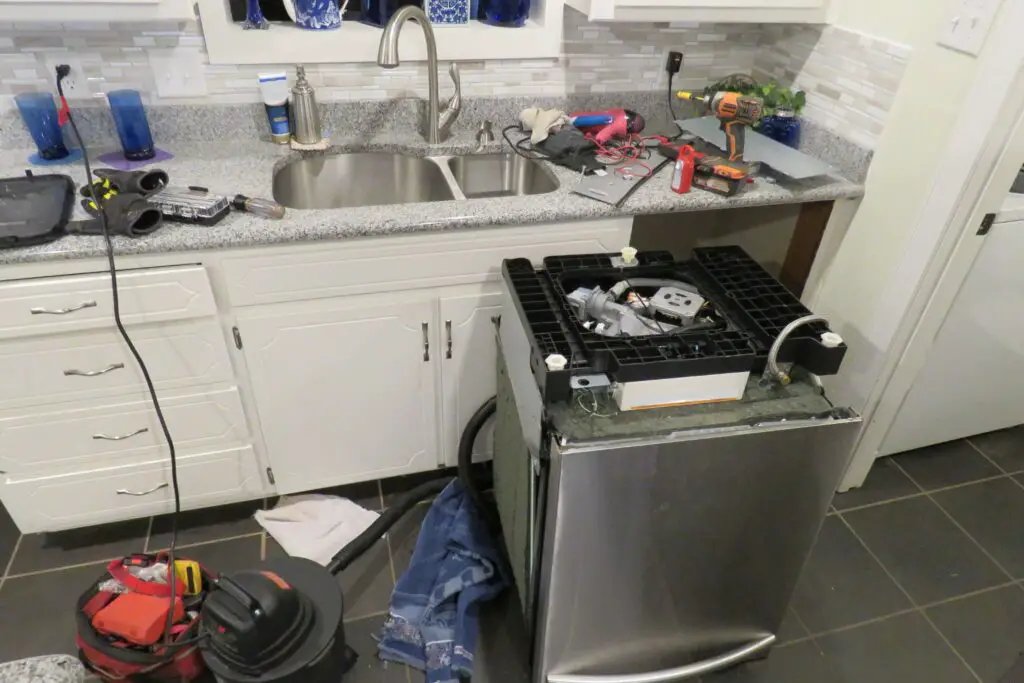Originally Created on: March 23, 2023 @ 11:06 am
Can you put a countertop dishwasher under the sink? Are you wondering whether this is possible?
Countertop dishwashers are an excellent solution for those who lack space in their kitchen, but are they suitable for placement under the sink?
This article will explore these questions and provide a comprehensive guide on the pros and cons of under-the-sink dishwashers and how to position them effectively.
You May Also Like: Can You Put A Countertop Dishwasher In A Cabinet? [The ULTIMATE Guide]
Table of Content
Can you put a countertop dishwasher under the sink?

Yes, installing a countertop dishwasher under the sink is possible, but it is not recommended. These appliances typically occupy less space vertically but may not leave enough room for the hot water pipes.
Luckily, most countertop dishwashers today are designed to fit under the sink, so check the clearance before purchasing.
Before you decide to install it under the sink, it is important to consider some factors, such as :
- Height clearance: Most countertop dishwashers require at least 22 inches of height clearance. Ensure that your sink cabinet is tall enough to accommodate the dishwasher.
- Plumbing: You’ll need to connect the dishwasher to your sink’s plumbing, which may require additional hoses and adapters. Ensure you have the necessary tools and knowledge to install the plumbing correctly.
- Electrical outlet: You’ll also need an electrical outlet near the sink cabinet where you plan to install the dishwasher.
- Ventilation: Under-sink cabinets can be prone to moisture buildup, damaging the dishwasher. Ensure adequate ventilation in the cabinet to prevent this from happening.
Where Do I Put My Countertop Dishwasher?

Where you plan to install the countertop dishwasher should depend on how you’ll use it. Before purchasing your appliance, consider where you’ll most often need to wash your dishes and how far away this location is from the nearest water tap.
Placing the dishwasher somewhere nearby will ensure you don’t have to travel too far for a wash cycle.
Some common places to put a countertop dishwasher include:
- On a kitchen cart or island
- On a small table or stand next to the sink: Since the dishwasher must be connected to the sink’s plumbing, it’s best to place it as close to the sink as possible. This will also make it easier to load and unload dishes.
- On a stable surface: Make sure the surface where you place the dishwasher is sturdy and stable enough to hold the weight of the appliance and the dishes.
- On a dedicated shelf or cabinet built specifically for the dishwasher
- Near an electrical outlet: You’ll need to plug the dishwasher into an electrical outlet, so make sure there’s one nearby.
Ultimately, the best place to put your countertop dishwasher will depend on your unique kitchen layout and needs.
Take the time to consider your options and choose a spot that will be convenient and functional for you.
Pros And Cons Of Under The Sink Dishwasher
Installing a dishwasher under the sink has its advantages and disadvantages. Here are the pros and cons:
Pros:
- Space-saving: Under-the-sink dishwashers are a great option for those with limited kitchen space. They take up less floor and counter space than traditional dishwashers, leaving more room for other appliances or storage.
- Discreet: Since under the sink dishwashers are installed beneath the sink, they are less visible and can blend in with the surrounding cabinetry, giving your kitchen a neater appearance.
- Accessibility: The proximity between the dishwasher and the sink makes loading and unloading much easier than in a freestanding setup.
- Concealed design: Installing a dishwasher under the sink can help keep your kitchen looking neat and tidy.
- Easy water connection: Since the dishwasher must be connected to your sink’s plumbing, you can connect pipes from the faucet to the machine beneath it.
Cons:
- Limited capacity: Under-the-sink dishwashers are generally smaller than traditional dishwashers and can hold fewer dishes. You may need to run the dishwasher more frequently or handwash larger items.
- Installation can be challenging: Installing an under-the-sink dishwasher can be more difficult than installing a traditional dishwasher, especially if you have no experience with plumbing or electrical work.
- Maintenance can be difficult: Since under-the-sink dishwashers are installed in a tight space, accessing and cleaning the dishwasher can be more challenging than a traditional dishwasher.
- May require modifications: Depending on your plumbing setup, you may need to make modifications to your plumbing to install an under-the-sink dishwasher.
- Moisture buildup: Under-sink cabinets can be prone to moisture buildup, damaging the dishwasher.
Positioning Your Under The Sink Dishwasher

When installing an under-sink dishwasher, positioning is critical. Here are some tips to ensure that your dishwasher is positioned correctly:
- Ensure that the dishwasher is level: A level dishwasher will ensure it runs smoothly and efficiently.
- Place the dishwasher on a platform: Placing it on a platform will prevent it from contacting any moisture that may build up in the cabinet.
- Install a drain pump: A drain pump can help prevent backflow and ensure the dishwasher drains properly.
- . Consider installing a ventilation fan or leaving the cabinet doors open after running the dishwasher to allow air to circulate.
- Maintenance plan: Ensure you can easily access the dishwasher for routine maintenance and cleaning. Consider installing a removable panel or leaving enough clearance to remove the dishwasher if needed.
Conclusion
A countertop dishwasher is an excellent appliance for washing dishes quickly, efficiently, and with minimal hassle. But can you put a countertop dishwasher under the sink? Yes, you can install a countertop dishwasher under the sink. Under the sink, dishwashers can be a convenient and space-saving option for those with limited kitchen space or who prefer a more discreet dishwasher. However, it requires careful consideration of plumbing, electrical, and ventilation requirements.
When choosing a location for your under-the-sink dishwasher, consider factors such as adequate clearance, proximity to water supply and drain lines, ventilation, and ease of maintenance. By following these guidelines, you can make an informed decision and enjoy the convenience of a compact and efficient dishwasher in your kitchen.

![Can You Put A Countertop Dishwasher Under The Sink? [+ 4 TIPS]](https://mykitchenapex.com/wp-content/uploads/2023/03/Can-You-Put-A-Countertop-Dishwasher-Under-The-Sink-4-TIPS.jpg)